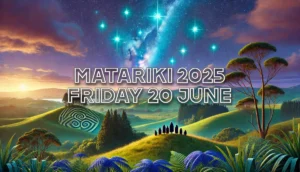The Seven Stars of Matariki
The Seven Stars of Matariki: Meanings and Significance
Matariki, also known as the Seven Sisters, is a group of stars that appear in the night sky in New Zealand during the winter months. The Māori New Year begins with the rise of Matariki, which traditionally marks the end of one year and the beginning of another. Matariki is an important cultural event for Māori people, and the significance of each star within the cluster is deeply rooted in Māori mythology and history. We will explore the meanings and significance of each of the seven stars of Matariki, providing an in-depth understanding of their importance to Māori culture.
- Matariki – The Mother Matariki is the mother star and is considered the most significant star in the cluster. She is often referred to as the ‘eyes of the god’ and is associated with the goddess of fertility and motherhood, Papatūānuku. Matariki is the star that signifies the beginning of the Māori New Year, and her appearance in the sky is seen as a time for reflection, renewal, and new beginnings.
- Pōhutukawa – The Star of Remembrance Pōhutukawa is the star of remembrance and is associated with those who have passed away. It is believed that the spirits of the dead return to the earth during the rise of Matariki, and Pōhutukawa is the star that guides them. This star is also associated with healing and regeneration, making it an important symbol of hope and renewal.
- Waitī – The Star of Freshwater Waitī is the star of freshwater and is associated with the lakes, rivers, and streams of the earth. It is said that Waitī is responsible for the abundance of freshwater and the life that it brings. Waitī is also associated with the traditional Māori practice of kaitiakitanga, or guardianship, of the environment.
- Waitā – The Star of the Ocean Waitā is the star of the ocean and is associated with the vast bodies of water that surround New Zealand. It is said that Waitā is responsible for the abundance of seafood and the life that it brings. Waitā is also associated with the traditional Māori practice of kaitiakitanga, or guardianship, of the ocean.
- Tupuānuku – The Star of Food Tupuānuku is the star of food and is associated with the earth and the crops that it produces. It is said that Tupuānuku is responsible for the abundance of food and the life that it brings. This star is also associated with the traditional Māori practice of kaitiakitanga, or guardianship, of the land.
- Tupuārangi – The Star of Music Tupuārangi is the star of music and is associated with the arts, specifically music and poetry. It is said that Tupuārangi is responsible for the inspiration and creativity that brings beauty to the world. This star is also associated with the traditional Māori practice of kaitiakitanga, or guardianship, of the arts.
- Ururangi – The Star of the Winds Ururangi is the star of the winds and is associated with the four winds that bring change and new beginnings. It is said that Ururangi is responsible for the movement of the stars and the balance of the universe. This star is also associated with the traditional Māori practice of kaitiakitanga, or guardianship, of the atmosphere.
Seven Stars of Matariki
Matariki and its seven stars hold a deep significance in Māori culture and tradition. Each star is associated with a different aspect of life on earth



Tena koe,
Have you thought about adding,
Waipunarangi and Hiwaiterangi
What part of Matariki do they associate with (sung in a waiata)
Kia ora,
Angelique
yeah, she’s right there are 9 stars in the constellation
In Hauraki we only see 7 stars therefore only recognise 7.
GREAT